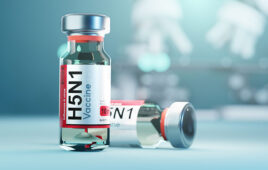
A new cancer-drug delivery system shows the ability to exploit the oxygen-poor areas of solid tumors that make the growths resistant to standard chemotherapy and radiation treatment.
Carcinomas that affect the breast, lung, prostate and colon are among these solid-tumor cancers, as are malignancies in the lymphatic system, known as lymphomas, and the much less common sarcomas that arise in connective tissue.
These solid masses often contain hypoxic regions, where the concentration of oxygen in the tissue is low. Hypoxic cancer cells grow slowly, and that makes them less susceptible to the drugs prescribed to kill or damage them.
Researchers at Oregon State University have found a way to turn the tables on those cells using a “prodrug” loaded into nanostructured platforms.
A prodrug is a pharmacologically inactive compound that the body metabolizes into an active drug, in this case the cancer drug vinblastine.
Provided with the prodrug vinblastine-N-oxide by research partners at Cascade Prodrug Inc. of Eugene, Oregon, OSU scientists developed two different lipid-based platform formulations known as liposomes to carry the prodrug to the tumor’s hypoxic regions. There, the lack of oxygen triggers its metabolic conversion to vinblastine.
In both formulations – one with polyethylene glycol on its surface, one without – the prodrug proved both safe and much more effective against non-small cell lung cancer than when it was delivered without a liposome.
“One of the hallmarks of these solid tumors is their hypoxic regions,” said the study’s lead author, Adam Alani of the OSU College of Pharmacy. “One reason these cancers become very aggressive is the development of this hypoxia. Since the late 1990s, researchers have been trying to take advantage of the hypoxia.
“The tumor model we chose, lung cancer, is one of the very well established tumors and there’s a very strong hypoxia associated with that – as well as, lung cancer is one of these cancers that in its advanced stages, it’s a terminal disease, and there’s a need for new treatments.”
By itself, vinblastine-N-oxide had shown less than optimal efficacy in testing by Cascade Prodrug because of how fast the body clears it from the system – it has a half-life of less than half an hour.
“When it was tested in mice and dogs, it did not have a chance to assimilate in the cancer tissue to produce the desired pharmacological effect,” Alani said.
But the liposomes – both the “pegylated” one containing polyethylene glycol, and the non-pegylated one – increased the half-life dramatically to 9.5 and 5.5 hours, respectively.
“The nano carriers performed much better than the prodrug itself,” Alani said. “We were able to literally cure the tumor.”
Alani’s research began with laboratory cultures and progressed to safety and efficacy testing in animals.
“We made sure the nanostructure platform worked properly against lung cancer in vitro, then looked at the safety of the formulation in healthy mice and looked at the maximum tolerated dose – the biggest dose you can use without producing side effects,” Alani said. “Then we determined how long the nano carriers could keep the drug in the blood compared to the drug without the nanostructures.”
When those data were “very encouraging,” Alani’s team assessed the efficacy of the formulations in mice that had tumors grafted into them.
Without any liposome, the drug showed some tumor suppression, but the mice that had received the drug alone had to be euthanized after 70 days because of tumors that were no longer being controlled.
Mice that had received the drug with one of the liposomes were healthy and tumor-free for the nearly 100-day run of the experiment.
“The formulations clearly performed better than the unformulated drug as well as much better than Cisplatin, the standard-of-care drug for this research,” Alani said. “Now we’re collaborating with Cascade Prodrug and the College of Veterinary Medicine to assess safety and efficacy in dog models, and trying to look at other tumors, like bladder cancer, associated with dogs.”
One goal, Alani said, is to develop a new treatment for cancer in dogs, and another is to look at dogs as a model for drug development – “to get data Cascade can use to move the process forward for approval for use in dogs, as well as preliminary data for a new drug application with the FDA,” Alani said.
Filed Under: Drug Discovery




